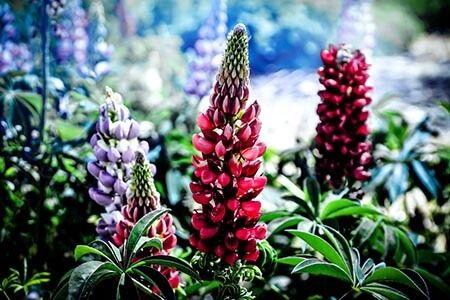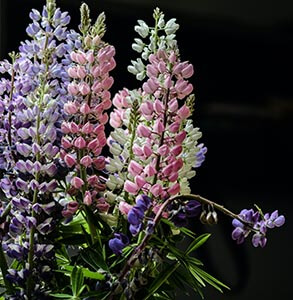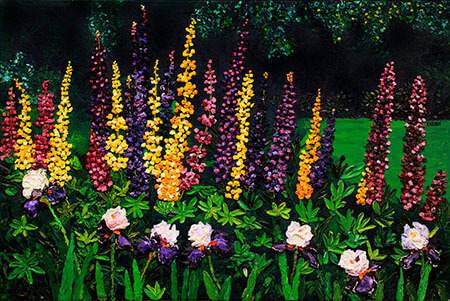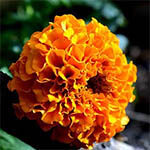
Lupine Flower Meaning
Develop Amazing Imagination and New Opportunities
Lupine flower meaning includes imagination, a hunger for life, a positive outlook and new opportunities. The primary meaning (imagination) derives from the fact that lupines can bring lush growth to areas that are parched or damaged. To envision a beautiful meadow of lupines in the place of scorched land takes some positive imagination!
Share this page with a friend!
Meaning of the Lupine Name
Contrary to this amazing ability to replenish deserted areas, lupines were once thought to rob the soil of nutrients. This is the origin of their name. The Latin word “lupinus” means “of wolves.” This belief also led to the connection between lupine flower meaning and the moon. In actuality, lupines add nitrogen to the soil.
Lupine Flower Meaning in Roman Times
Lupine flower meaning was literal for the Romans: money and food. They used the flat seeds for theater money. They also ate the nutritious seeds which have a protein content similar to soy but contain less fat. Lupine seeds are gluten-free, high in fiber, high in amino acids and antioxidants, fatty acids, and are prebiotic. If you’d like to try eating lupines, be aware that there are some poisonous varieties. Please do further research or contact an expert in plant identification.
Consuming Lupine Seeds
The seeds are soaked in a brine or warm water, then toasted or cooked to remove nitrogen alkaloids. Lupine seeds can be made into flour, which can then be made into pasta. The seeds can also be processed to make cooking oil. The Roman use of lupines for food is not a unique phenomenon. This beautiful, flowering legume has been cultivated and eaten for over 6,000 years by people in the Andes, the Mediterranean and Egypt.
Native American Legend About Lupines
A legend in the Native American tradition tells of a time when a tribe was dying of starvation after a long drought. They believed that generosity and selflessness would turn this situation around. However, no one had come forward with an appropriate deed. Finally an orphan girl climbed a hill. She offered her last possession, a beloved doll.
Saving a Tribe from Starvation
After she had placed the doll on the hillside, the rain began to fall. Lupines sprouted up and covered the hillside. The nutritious seeds of the lupines could be harvested for food. The gift of the little girl had saved the tribe. The story illustrates multiple aspects of lupine flower meaning including a positive outlook and new opportunities.
Lupines as Food and Medicine
In addition to being an extremely useful food for humans, wild lupines are also a wonderful source of protein for grazing livestock like cattle, sheep, and horses. Furthermore, ground lupine seeds can be used for fertilizer.
Medicinal Uses for Lupine Seeds
The seeds of lupines are said to aid digestion. The seeds have also been used in skincare for removing spots from the face. Lupine flowers are rich in antioxidants. They contain peptides that aid in protecting skin and reversing damage that might cause premature aging.
Native American Traditions with Lupines
Native Americans used lupine leaves for medicinal purposes: brewing a tea said to help treat nausea, inflammation, constipation, and internal bleeding. They also made a poultice out of the plant to treat boils and arthritis.
Lupines as Food for Butterflies and More
Besides their use as food for humans and livestock, lupines are the only food for the Karner blue butterfly’s caterpillar. The larvae crawl up the stems of wild lupines to feed on the new leaves in mid-April. Finally, lupine flowers are useful for dyeing cloth. Lupines come in many colors including blue, purple, pink, white and yellow. Learn more in our article on Flower Color Meaning.
Lupine Flower Meaning in the Garden
The tall, stately spikes of lupine flowers are covered with a multitude of blossoms. Since they are often blue or purple, they are also known as bluebonnets. This common variety is the state flower of Texas.
The Aroma of Lupines
The scent from lupine blossoms is like that of honey, a nice addition to any garden. The magnificent flower spikes can be from 36-60 inches high. Lupines need full sun, rich soil and lots of moisture. They can grow in poor soils if the soil is not too alkaline.
Growing Lupines
In the United States, lupines grow well in the Pacific Northwest, the West Coast, New England and other northern states. They are both cultivated flowers and wildflowers. Lupines also grow abundantly throughout Europe as far north as Norway.
Related Flower Articles
LUPINE MEANING ARTICLE SUMMARY
Lupines are spectacular flowers that grow wild around the world and have been bred and adapted for domestic gardens. The history of lupines includes Roman uses of the plant as well as native American stories. Learn more in this article about lupine flower meaning, uses of lupines and growing lupine flowers.
Author Kathleen Karlsen
Kathleen Karlsen is a musician, artist, writer and speaker. She is the author of two books (Flower Symbols and Vocal Medicine) and over 200 articles. Kathleen, her husband Andrew, and their five children live in Bozeman, Montana. More about Kathleen Karlsen.










